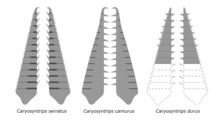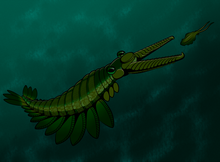Caryosyntrips
| Caryosyntrips Temporal range:
| |
|---|---|

| |
| Frontal appendages of Caryosyntrips | |

| |
| Speculative life restoration as a radiodont | |
| Scientific classification | |
| Domain: | Eukaryota |
| Kingdom: | Animalia |
| Stem group: | Arthropoda |
| Genus: | †Caryosyntrips Daley & Budd, 2010 |
| Type species | |
| Caryosyntrips serratus Daley & Budd, 2010
| |
| species | |
Caryosyntrips ("nutcracker") is an extinct genus of stem-arthropod which known from Canada, United States and Spain during the middle Cambrian.[1] It was first named by Allison C. Daley and Graham E. Budd in 2010, being the type species Caryosyntrips serratus.[2]
Etymology
[edit]The scientific name Caryosyntrips comes from Greek karyon, "nut"; and syntrips, "the smasher", a spirit from Greek mythology.[2]
Occurrence
[edit]Multiple species had been recovered from the Burgess Shale Formation, Canada, Wheeler Shale and Marjum Formation, United States, and Valdemiedes Formation, Spain.[1][3] The latter contain a large specimen, which was initially misidentified as a body remain of lobopodian ("Mureropodia apae").[4][1][5][6]
Description
[edit]-
Fossil frontal appendages of C. serratus
-
Fossil frontal appendages of C. camurus
-
Fossil frontal appendages of C. durus
-
Fossil frontal appendage of C. cf. camurus (=Mureropodia apae)
-
Presumed grasping motion of C. camurus
-
Sizes of various Caryosyntrips specimens, based on the interpretation as radiodonts.[6]
Caryosyntrips is known only from its 14-segmented frontal appendages, which resemble nutcrackers, with the endite (ventral spine)-bearing margin facing each other, and the bell-shaped bases might represent movable articulations with the animal's head.[1] Details of the endites, terminal spines, segmental boundaries and outer margins differ between species.[1] It is thought to have used their frontal appendages in a scissor-like grasping or slicing motion, and were probably durophagous, feeding on hard-shelled organisms.[1] Other structures remain unknown, although a specimen with paired appendages possibly contain other fragmental head sclerites as well.[2][3]
The size of Caryosyntrips differed between each species. The largest species is C. serratus which is estimated around 20.5–30.2 cm (8.1–11.9 in) long. Other species are much smaller, with the body lengths of C. camurus and C. durus estimated up to 13.7–20.2 cm (5.4–8.0 in) and 12.2–17.9 cm (4.8–7.0 in) respectively. The largest possible specimen (MPZ 2009/1241), identified as C. cf. camurus, would have belonged to an individual measuring between 36.7–54 cm (1.20–1.77 ft) long.[7]
Taxonomic affinities
[edit]As of 2010s, Caryosyntrips was long considered to be a basal radiodont of uncertain position, usually resolved in a polytomy between euarthropod and radiodont branches.[8][9][10][6][11][12] however more recent papers have found that it may sit outside of the monophyletic Radiodonta all together.[12][13] Due to the unusual morphology of the frontal appendages and the limited extent of known remains, its position within the arthropod stem-group remains uncertain.[1][13]
| Panarthropoda |
| |||||||||||||||||||||||||||||||||
See also
[edit]- Cucumericrus, another stem-arthropod with similar uncertainties.
References
[edit]- ^ a b c d e f g h i Stephen Pates; Allison C. Daley (2017). "Caryosyntrips: a radiodontan from the Cambrian of Spain, USA and Canada". Papers in Palaeontology. 3 (3): 461–470. Bibcode:2017PPal....3..461P. doi:10.1002/spp2.1084. S2CID 135026011.
- ^ a b c Allison C. Daley, Graham E. Budd (2010). "New anomalocaridid appendages from the Burgess Shale, Canada". Palaeontology. 53 (4): 721–738. Bibcode:2010Palgy..53..721D. doi:10.1111/j.1475-4983.2010.00955.x.
- ^ a b Pates, Stephen; Lerosey-Aubril, Rudy; Daley, Allison C.; Kier, Carlo; Bonino, Enrico; Ortega-Hernández, Javier (2021-01-19). "The diverse radiodont fauna from the Marjum Formation of Utah, USA (Cambrian: Drumian)". PeerJ. 9: e10509. doi:10.7717/peerj.10509. ISSN 2167-8359. PMC 7821760. PMID 33552709.
- ^ Gámez Vintaned, José Antonio; Liñán, Eladio; Yu. Zhuravlev, Andrey (2011), Pontarotti, Pierre (ed.), "A New Early Cambrian Lobopod-Bearing Animal (Murero, Spain) and the Problem of the Ecdysozoan Early Diversification", Evolutionary Biology – Concepts, Biodiversity, Macroevolution and Genome Evolution, Berlin, Heidelberg: Springer, pp. 193–219, doi:10.1007/978-3-642-20763-1_12, ISBN 978-3-642-20763-1, retrieved 2024-01-05
- ^ Pates, Stephen; Daley, Allison; Ortega-Hernández, Javier (2018). "Response to Comment on "Aysheaia prolata from the Utah Wheeler Formation (Drumian, Cambrian) is a frontal appendage of the radiodontan Stanleycaris" with the formal description of Stanleycaris". Acta Palaeontologica Polonica. 63. doi:10.4202/app.00443.2017. ISSN 0567-7920.
- ^ a b c Lerosey-Aubril, Rudy; Pates, Stephen (2018-09-14). "New suspension-feeding radiodont suggests evolution of microplanktivory in Cambrian macronekton". Nature Communications. 9 (1): 3774. Bibcode:2018NatCo...9.3774L. doi:10.1038/s41467-018-06229-7. ISSN 2041-1723. PMC 6138677. PMID 30218075.
- ^ Lerosey-Aubril, Rudy; Pates, Stephen (2018-09-14). "New suspension-feeding radiodont suggests evolution of microplanktivory in Cambrian macronekton". Nature Communications. 9 (1): 3774. Bibcode:2018NatCo...9.3774L. doi:10.1038/s41467-018-06229-7. ISSN 2041-1723. PMC 6138677. PMID 30218075. Dryad Data
- ^ Jakob Vinther; Martin Stein; Nicholas R. Longrich & David A. T. Harper (2014). "A suspension-feeding anomalocarid from the Early Cambrian" (PDF). Nature. 507 (7493): 496–499. Bibcode:2014Natur.507..496V. doi:10.1038/nature13010. PMID 24670770. S2CID 205237459.
- ^ Cong, Peiyun; Ma, Xiaoya; Hou, Xianguang; Edgecombe, Gregory D.; Strausfeld, Nicholas J. (September 2014). "Brain structure resolves the segmental affinity of anomalocaridid appendages". Nature. 513 (7519): 538–542. Bibcode:2014Natur.513..538C. doi:10.1038/nature13486. ISSN 1476-4687. PMID 25043032. S2CID 4451239.
- ^ Van Roy, Peter; Daley, Allison C.; Briggs, Derek E. G. (June 2015). "Anomalocaridid trunk limb homology revealed by a giant filter-feeder with paired flaps". Nature. 522 (7554): 77–80. Bibcode:2015Natur.522...77V. doi:10.1038/nature14256. ISSN 1476-4687. PMID 25762145. S2CID 205242881.
- ^ Liu, Jianni; Lerosey-Aubril, Rudy; Steiner, Michael; Dunlop, Jason A; Shu, Degan; Paterson, John R (2018-06-01). "Origin of raptorial feeding in juvenile euarthropods revealed by a Cambrian radiodontan". National Science Review. 5 (6): 863–869. doi:10.1093/nsr/nwy057. ISSN 2095-5138.
- ^ a b Moysiuk, J.; Caron, J.-B. (2019-08-14). "A new hurdiid radiodont from the Burgess Shale evinces the exploitation of Cambrian infaunal food sources". Proceedings of the Royal Society B: Biological Sciences. 286 (1908): 20191079. doi:10.1098/rspb.2019.1079. ISSN 0962-8452. PMC 6710600. PMID 31362637.
- ^ a b McCall, Christian (13 December 2023). "A large pelagic lobopodian from the Cambrian Pioche Shale of Nevada". Journal of Paleontology: 1–16. doi:10.1017/jpa.2023.63. S2CID 266292707. Retrieved 13 December 2023.
External links
[edit]- "Caryosyntrips serratus". Burgess Shale Fossil Gallery. Virtual Museum of Canada. 2011. Archived from the original on March 23, 2023.






![Sizes of various Caryosyntrips specimens, based on the interpretation as radiodonts.[6]](http://upload.wikimedia.org/wikipedia/commons/thumb/1/13/20210215_Caryosyntrips_size.png/135px-20210215_Caryosyntrips_size.png)
